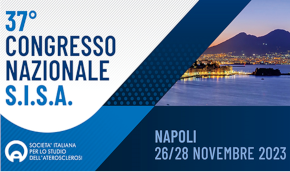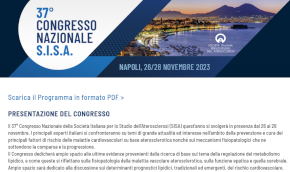 Rivista in lingua italiana
Rivista in lingua italiana
riservata ai Soci SISA
Ultimo numero:
Anno 14 • N.4/2023
SISANews
La PET delle carotidi è predittiva di eventi cardiovascolari
La tomografia a emissione di positroni (PET) è una metodica non invasiva che viene principalmente usata nella diagnostica dei tumori, ma non sono solo le cellule neoplastiche a captare il fluoro-2-desossiglucosio, ma anche altre cellule metabolicamente attive, per esempio le cellule infiammatorie, captano, metabolizzano il radio farmaco ed emettono positroni. La PET è quindi in grado di riconoscere i tessuti infiammati e quindi nulla di strano se dovesse segnalare i tronchi arteriosi interessati da un processo aterosclerotico. Nei 1089 pazienti asintomatici che si erano sottoposti a PET nell'ambito di un programma di screening per tumori, un'alta captazione di fluoro-2-desossiglucosio a livello delle carotidi si è dimostrata significativamente associata ad un aumentato rischio di eventi cardio-cerebrovascolari, indipendentemente dai tradizionali fattori di rischio.
![]()
Carotid FDG Uptake Improves Prediction of Future Cardiovascular Events in Asymptomatic Individuals
Moon SH, Cho YS, Noh TS, Choi JY, Kim BT, Lee KH
J Am Coll Cardiol Img 2015;8:949-956
Objectives: This study sought to investigate the role of carotid fluoro-2-deoxyglucose (FDG) uptake as an independent prognostic indicator and to determine whether its addition improves risk prediction beyond the Framingham risk score (FRS) and carotid intima-media thickness (CIMT).
Background: The prognostic value of carotid FDG uptake independent of and incremental to traditional cardiovascular risk factors and CIMT in asymptomatic individuals has not been evaluated.
Methods: We measured carotid FDG uptake and CIMT in 1,089 asymptomatic adults (51.8 ± 6.3 years of age, 94.3% males) who underwent positron emission tomography/computed tomography imaging and examined the prognostic value of carotid FDG uptake compared with traditional risk factors and CIMT.
Results: Cardiocerebrovascular events occurred in 19 participants (1.74%) during an average follow-up of 4.2 years (range 1.0 to 5.5 years). Multivariable Cox proportional hazards analyses revealed that high carotid FDG uptake (hazard ratio: 2.98; 95% confidence interval: 1.17 to 7.62; p = 0.022) and high CIMT (hazard ratio: 2.82; 95% confidence interval: 1.13 to 7.03; p = 0.026) were independent predictors of events. Comparison of predictive power demonstrated that adding carotid FDG uptake, but not CIMT, to the FRS significantly increased the time-dependent area under the receiver-operating characteristic curve from 0.60 to 0.73 (p = 0.04). Furthermore, improvement approaching significance was achieved by adding carotid FDG uptake to the FRS plus CIMT, which increased the area under the receiver-operating characteristic curve from 0.65 to 0.75 (p = 0.07). Net reclassification for event prediction was similarly improved by addition of carotid FDG uptake to the FRS (net reclassification index, 40.1%; p = 0.06), as well as the FRS plus CIMT (net reclassification index, 32.9%; p = 0.07).
Conclusions: High carotid FDG uptake predicts cardiovascular events independent of traditional risk factors and CIMT in asymptomatic adults and may add to risk stratification beyond the FRS and CIMT.
J Am Coll Cardiol Img 2015;8:949-956

Area Soci
Eventi



 SISA LIPID ACADEMY - Corso avanzato di lipidologia clinica
SISA LIPID ACADEMY - Corso avanzato di lipidologia clinicaModena, 22-23 Giugno 2023
[continua a leggere]Giornale Italiano Arteriosclerosi
HoFH today
 Rivista Italiana della
Rivista Italiana della
Ipercolesterolemia
Familiare Omozigote
Anno 5 • N.1/2023
Rivista NMCD
Diateca
[continua a leggere]
[continua a leggere]
Newsletter
il vostro indirizzo di posta elettronica
Progetto LIPIGEN

Nuovo sito dedicato al Progetto LIPIGEN
Progetto LIPIGEN - Vecchio portale
E' necessario essere loggati come utente
Lipigen per poter accedere alla pagina
PROject Statin Intolerance SISA
PROSISA – PROject Statin Intolerance SISA
E' necessario essere loggati come utente
PROSISA per poter accedere alla pagina
GILA - Lipoprotein Aferesi
Gruppo Interdisciplinare Lipoprotein Aferesi
(Accesso Gruppo GILA-Lipoprotein Aferesi)
E' necessario essere loggati come utente del Gruppo GILA per poter accedere
Gruppo Interdisciplinare Lipoprotein Aferesi
(Documentazione ad accesso libero)
Pagina informativa per medici e pazienti








